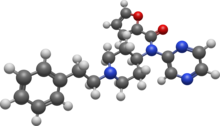
Mirfentanil

| |

| |
| Names | |
|---|---|
|
Preferred IUPAC name
N-[1-(2-Phenylethyl)piperidin-4-yl]-N-pyrazinylfuran-2-carboxamide | |
| Other names
MS-32, NIH-10647
| |
| Identifiers | |
|
3D model (JSmol)
|
|
| ChemSpider |
|
| MeSH | C069209 |
|
PubChem CID
|
|
| UNII | |
|
CompTox Dashboard (EPA)
|
|
| |
| |
| Properties | |
| C22H24N4O2 | |
| Molar mass | 376.460 g·mol−1 |
|
Except where otherwise noted, data are given for materials in their standard state (at 25 °C [77 °F], 100 kPa).
| |
Mirfentanil is a fentanyl derivative with strong selectivity for the μ opioid receptor. At lower doses, it antagonizes the analgesic effects of alfentanil and substitutes for naloxone in morphine-treated monkeys; however, it also reverses naloxone-precipitated withdrawal in pigeons trained to discriminate morphine from naloxone.
At high doses, it exhibits analgesic activity which is not fully reversed by opioid antagonists, suggesting that the drug has both opioid and non-opioid mechanisms of action.
Side effects of fentanyl analogs are similar to those of fentanyl itself, which include itching, nausea and potentially serious respiratory depression, which can be life-threatening. Fentanyl analogs have killed hundreds of people throughout Europe and the former Soviet republics since the most recent resurgence in use began in Estonia in the early 2000s, and novel derivatives continue to appear.
Synthesis
Mirfentanil was synthesized via acylation of the product of the reaction of 2-chloropyrazine and 1-(2-phenylethyl)-4-piperidinone oxime with 2-furoyl chloride.
See also
- 3-Methylbutyrfentanyl
- 3-Methylfentanyl
- 4-Fluorofentanyl
- α-Methylfentanyl
- Acetylfentanyl
- Butyrfentanyl
- Furanylfentanyl
External links
-
 Media related to Mirfentanil at Wikimedia Commons
Media related to Mirfentanil at Wikimedia Commons